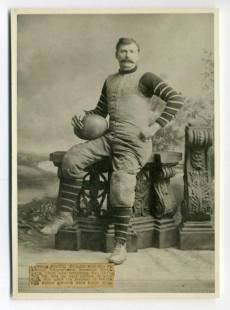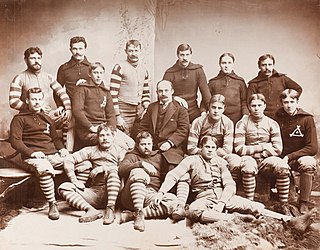Related Research Articles
The Allegheny Athletic Association was an athletic club that fielded the first ever professional American football player and later the first fully professional football team. The organization was founded in 1890 as a regional athletic club in Allegheny, Pennsylvania, which is today the North Side of Pittsburgh.
The Greensburg Athletic Association was an early organized football team, based in Greensburg, Pennsylvania, that played in the unofficial Western Pennsylvania Professional Football Circuit from 1890 until 1900. At times referred to as the Greensburg Athletic Club, the team began as an amateur football club in 1890 and was composed primarily of locals before several professional players were added for the 1895 season. In 1894 it was discovered that the team had secretly paid formerly Indiana Normal player, Lawson Fiscus, to play football and retained his services on salary. The team was the chief rival of another early professional football team, the Latrobe Athletic Association.
The PittsburghAthletic Club football team, established in 1890, was based in Pittsburgh, Pennsylvania. In 1892 the intense competition between two Pittsburgh-area clubs, the Allegheny Athletic Association and the Pittsburgh Athletic Club, led to William (Pudge) Heffelfinger becoming the first known professional football player. Heffelfinger was paid $500 by Allegheny to play in a game against Pittsburgh on November 12, 1892. As a result, Heffelfinger became the first person to be paid to play football. Allegheny would go on to win the game, 4–0, when Heffelfinger picked up a Pittsburgh fumble and ran it 35 yards for a touchdown. In 1893, Pittsburgh again made history when it signed one of its players, probably halfback Grant Dibert, to the first known pro football contract, which covered all of the team's games for the year.
The Duquesne Country and Athletic Club was a professional football team based in Pittsburgh, Pennsylvania from 1895 until 1900. The team was considered one of the best, if not the best, professional football teams in the country from 1898 until 1900. However, the team is most famous for being the first football franchise to be owned by an individual, William Chase Temple.

Ira Lawson Fiscus (1866-1949) was one of the first professional football players. He attended Princeton University, where his outstanding play at offensive guard earned him the title Samson of Princeton, before going on to play professionally with the Allegheny Athletic Association in 1891 and the Greensburg Athletic Association in 1893. His brothers Ross and Newell also played for Pittsburgh-area athletic clubs and were highly regarded as players.
Benjamin Shenstone "Sport" Donnelly was an American football player and coach. He was the second-ever known professional football player, behind Pudge Heffelfinger. He was paid $250 for one game on November 19, 1892 by the Allegheny Athletic Association, for a game against the Washington & Jefferson Presidents football team. The November 19 date was exactly seven days after the team paid Heffelfinger $500 for a game. In 1893, Donnelly was hired by the Allegheny Athletic Association as player-coach, making him the first man to ever coach a known pro team. Heffelfinger once said that Donnelly was the only man that he had played against who "could slug you and at the same time keep his eyes on the ball". Donnelly also served as the second head football coach at the University of Iowa for a single season in 1893, compiling a record of 3–4.

The Chicago Athletic Association was an American football team, based in Chicago, Illinois. The club itself had been organized in 1890, and in 1892 it formed a football team. The team was built around veterans of Chicago's University Club football team.
Oliver David Thompson, Esq. was an early football player at Yale, who played alongside Walter Camp. After his time at Yale, Thompson played, and served as the manager, for the Allegheny Athletic Association. However Thompson is best known for paying Pudge Heffelfinger $500 to play for Allegheny against their rivals, the Pittsburgh Athletic Club. Thompson's historic actions went unnoticed until the 1960s, when an 1892 account ledger prepared by Thompson – while he was manager of the Allegheny Athletic Association – included the line: "Game performance bonus to W. Heffelfinger for playing (cash) $500." The ledger is currently on display at the Pro Football Hall of Fame in Canton, Ohio.
Professor William Kirschner was an early football player and physical director for the Pittsburgh Athletic Club. He may, or may not, have been one of the earliest professional football players. Even though he had never played football before 1890, he had the ability to learn and adapt to the game quickly. During the 1890s he was viewed as one of the best offensive linemen in Pennsylvania.

Charles Elmer Aull was an early professional football player. He played professionally for the Pittsburgh Athletic Club. He also played college football from 1889 until 1891 for the Penn State Nittany Lions. He was born in Pittsburgh in 1869. He died in Ohio in 1958.

Augustus Clement Read was a college football player and the captain of the Penn State Nittany Lions football team, and a college shot putter. He was from Delano, Pennsylvania.
Abram Sharpless Valentine was an early professional football player for the Allegheny Athletic Association. He served as the team's quarterback in 1890 and 1891. However, he jumped to the rival Pittsburgh Athletic Club in 1892. Valentine played for Pittsburgh in their first two games. Then, without warning, he suddenly jumped back to the Allegheny team. Some Pittsburgh A.C. members accused Allegheny of enticing him back, while others charged he had all along been a spy for them. During Allegheny's two games against the Pittsburgh A.C. that year, Valentine played as a left halfback.
James M. Van Cleve was an American football player and coach. He was the fourth ever known person to be paid to play the sport. Only Pudge Heffelfinger, Sport Donnelly and Peter Wright were professionals before him. Van Cleve's contract was with the Allegheny Athletic Association for $50 per game for the entire 1893 season.
Oliver William Rafferty was an early professional football player. In 1893 he was under contract by the Allegheny Athletic Association to be paid $50 per game for the entire season. He returned to Allegheny in 1894 to help the club win the Western Pennsylvania Championship. In 1895 Rafferty was poised to return to play for Allegheny, however the club cancelled their season after learning of an investigation, by Amateur Athletic Union, into reports that the team had secretly paid its players.
Peter Wright was an early professional football player. In 1893, he was under contract by the Allegheny Athletic Association to be paid $50 per game for the entire season. That season Peter, Ollie Rafferty and James Van Cleve were all under contract.

William J. Kountz Jr. was an American businessman and an early football player for the Allegheny Athletic Association. He gained brief fame as a humorist with his "Billy Baxter" letters.
John K. Moorehead, Jr. was an American football player for Yale. He played alongside Walter Camp, the inventor of the modern game, during the late 1870s. He was also a member, and club president, of the Allegheny Athletic Association, an amateur football club which fielded the first recognized professional player Pudge Heffelfinger. When Allegheny formed a football team in 1890, he took over the position of center. Meanwhile a fellow former Yale player, O. D. Thompson, took over as the club's manager and played tackle.

The 1893 Pittsburgh Athletic Club football season was their fourth season in existence. The team finished with a record of 7–2.
The 1898 Duquesne Country and Athletic Club football season was their fourth season in existence. The team finished with a record of 10–0–1. The team was named the top team in western Pennsylvania. Roy Jackson was the team's captain and coach.
The Western Pennsylvania Professional Football Circuit was a loose association of American football clubs that operated from 1890 to approximately 1940. Originally amateur, professionalism was introduced to the circuit in 1892; cost pressures pushed the circuit to semi-professional status from about 1920 through the rest of its existence. Existing in some form for 48 years, it was one of the longest-lived paying football loops to operate outside the auspices of the National Football League.
References
- PFRA Research. "Five Hundred Reasons" (PDF). Coffin Corner. Professional Football Researchers Association: 1–6. Archived from the original (PDF) on 2010-09-29.
- PFRA Research. "Three A's for Football" (PDF). Coffin Corner. Professional Football Researchers Association: 1–4. Archived from the original (PDF) on 2010-09-29.
- PFRA Research. "Up the P.A.C." (PDF). Coffin Corner. Professional Football Researchers Association: 1–4. Archived from the original (PDF) on 2010-11-26.
- "General History - Chronology (1869 to 1939)". Pro Football Hall of Fame. Retrieved April 16, 2012.
- Peterson, Robert W. (1997). Pigskin: The Early Years of Pro Football. Oxford University Press. ISBN 0-19-511913-4.
- PFRA Research. "A Weekly Wage" (PDF). Coffin Corner. Professional Football Researchers Association: 1–4. Archived from the original (PDF) on 2010-11-26.